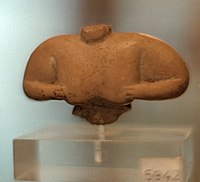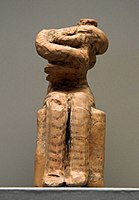Late Neolithic: Difference between revisions
पाटलिपुत्र (talk | contribs) →Europe: layout |
पाटलिपुत्र (talk | contribs) →Europe: text from "The Near-Eastern Roots of the Neolithic in South Asia" published under Creative Commons license CC BY 4.0 |
||
| Line 72: | Line 72: | ||
==Europe== |
==Europe== |
||
The [[Neolithic Europe|European Neolithic]] is generally dated to 7000–3000 BCE. The spread of the Neolithic in Europe was first studied quantitatively in the 1970s, when a sufficient number of 14C age determinations for early Neolithic sites had become available. [[Ammerman]] and [[Cavalli-Sforza]] discovered a linear relationship between the age of an Early Neolithic site and its distance from the conventional source in the Near East ([[Jericho]]), thus demonstrating that, on average, the Neolithic spread at a constant speed of about 1 km/yr. More recent studies confirm these results and yield the speed of 0.6–1.3 km/yr at 95% confidence level.<ref>Original text published under Creative Commons license CC BY 4.0: {{cite book |last1=Shukurov |first1=Anvar |last2=Sarson |first2=Graeme R. |last3=Gangal |first3=Kavita |title=The Near-Eastern Roots of the Neolithic in South Asia |date=2014 |page=1 |url=https://journals.plos.org/plosone/article?id=10.1371/journal.pone.0095714 |language=en}}</ref> |
|||
The [[Neolithic Europe|European Neolithic]] is generally dated to 7000–3000 BCE. |
|||
===Greece=== |
===Greece=== |
||
[[File:Sesklo neolithic 5300 BC, NAMA 080796.jpg|thumb|Findings from Sesklo, [[Neolithic]] Period, {{circa|5300 BC}}]] |
[[File:Sesklo neolithic 5300 BC, NAMA 080796.jpg|thumb|Findings from Sesklo, [[Neolithic]] Period, {{circa|5300 BC}}]] |
||
Revision as of 15:48, 10 May 2019

The Pottery Neolithic (abbreviated PN) began around 6,400 BC in the Fertile Crescent, succeeding the period of the Pre-Pottery Neolithic.[1] By then distinctive cultures emerged, with pottery like the Halafian (Turkey, Syria, Northern Mesopotamia) and Ubaid (Southern Mesopotamia). This period has been further divided into PNA (Pottery Neolithic A) and PNB (Pottery Neolithic B) at some sites.[2]
The Chalcolithic (Stone-Bronze) period began about 4500 BC, then the Bronze Age began about 3500 BC with the invention of writing, replacing the Neolithic cultures and starting the historical period.[3]
First experiments with pottery (circa 7000 BC)
The northern Mesopotamian sites of Tell Hassuna and Jarmo are some of the oldest sites in the Near-East where pottery has been found, appearing in the most recent levels of excavation, which dates it to the 7th millennium BC.[4] This pottery is handmade, of simple design and with thick sides, and treated with a vegetable solvent.[5] There are clay figures, zoomorphic or anthropomorphic, including figures of pregnant women which are taken to be fertility goddesses, similar to the Mother Goddess of later Neolithic cultures in the same region.
Halaf culture (6000-5000 BC, Northwestern Mesopotamia)
Pottery was decorated with abstract geometric patterns and ornaments, especially in the Halaf culture, also known for its clay fertility figurines, painted with lines. Clay was all around and the main material; often modelled figures were painted with black decoration. Carefully crafted and dyed pots, especially jugs and bowls, were traded. As dyes, iron oxide containing clays were diluted in different degrees or various minerals were mixed to produce different colours.
The Halaf culture saw the earliest known appearance of stamp seals.[6] They featured essentially geometric patterns.[6]
Female fertility figurines in painted clay, possibly goddesses, also appear in this period, circa 6000-5100 BC.[7]
-
Jar decorated with diverse geometric patterns; 4900-4300 BC; ceramic; by Halaf culture; Erbil Civilization Museum (Erbil, Iraq)
-
Shard; 5600-5000 BC; painted ceramic; 7.19 × 4.19 cm; by Halaf culture
-
Halaf culture female figurines, 6000-5100 BC Louvre Museum
-
Stamp seal and modern impression- geometric pattern. Halaf culture
-
Fragment of a bowl; 5600-5000 BC; 8.2 cm; by Halaf culture
-
Shard; 5600-5000 BC; painted ceramic; 3.96 × 5.21 cm; by Halaf culture
-
Jar decorated with diverse geometric patterns; 4900-4300 BC; ceramic; by Halaf culture; Erbil Civilization Museum (Erbil, Iraq)
Hassuna culture (6000-5000 BC, Northern Mesopotamia)
The Hassuna culture is a Neolithic archaeological culture in northern Mesopotamia dating to the early sixth millennium BC. It is named after the type site of Tell Hassuna in Iraq. Other sites where Hassuna material has been found include Tell Shemshara. The decoration of pottery essentially consists in geometrical shapes, and a few ibex designs.
-
Hassuna redware bowl, circa 5500 BC
-
Fragment of pottery with incised and painted decor. From Tell Hassuna, 6500 - 6000 BC.
-
Reconstitution of Neolithic dwelling in northern Mesopotamia (Akarcay Tepe II)
-
Reconstitution of Neolithic dwelling in northern Mesopotamia (Akarcay Tepe II)
Samarra culture (6000–4800 BC, Central Mesopotamia)
The Samarra culture is a Chalcolithic archaeological culture in northern Mesopotamia that is roughly dated to 5500–4800 BCE. It partially overlaps with the Hassuna and early Ubaid.
-
Samarra plate, with a design consists of a rim, a circle of eight fish, and four fish swimming towards the center being caught by four birds, at the center being a swastika symbol; circa 4000 BC; painted ceramic; diameter: 27.7 cm; Vorderasiatisches Museum (Berlin)
-
Samarra period fine ware, with central Ibex motif; circa 6200-5700 BC; Vorderasiatisches Museum
-
Fragment of Samarra pottery with geometrical designs in University of Chicago Oriental Institute (USA)
-
Female figurine found in the Tell es Sawwan (middle Tigris, near Samarra), level 1, ca. 6000 BC.
Ubaid culture (c.6500–3800 BC, Southern Mesopotamia)

The Ubaid period (c. 6500–3800 BC)[8] is a prehistoric period of Mesopotamia. The name derives from Tell al-'Ubaid in Southern Mesopotamia, where the earliest large excavation of Ubaid period material was conducted initially by Henry Hall and later by Leonard Woolley.[9]
In South Mesopotamia the period is the earliest known period on the alluvial plain although it is likely earlier periods exist obscured under the alluvium.[10] In the south it has a very long duration between about 6500 and 3800 BC when it is replaced by the Uruk period.[11]
In North Mesopotamia, Ubaid culture expanded during the period between about 5300 and 4300 BC.[11] It is preceded by the Halaf period and the Halaf-Ubaid Transitional period and succeeded by the Late Chalcolithic period. The new period is named Northern Ubaid to distinguish it from the proper Ubaid in southern Mesopotamia.[12]
With Ubaid 3 (circa 4500 BC) numerous examples of Ubaid pottery have been found along the Persian Gulf, as far as Dilmun, where Indus Valley Civilization pottery has also been found.[13]
Stamps seals start to depict animals in stylistic fashion, and also bear the first known depiction of the Master of Animals at the end of the period, circa 4000 BC.[14][15][16]
-
Jar; Late Ubaid period (4500-4000 BC); pottery; from Southern Iraq; Museum of Fine Arts, Boston (USA)
-
Female figurines; 4700-4200 BC; ceramic; from Girsu; Louvre[18]
-
Terracotta stamp seal with Master of Animals motif, Tello, ancient Girsu, End of Ubaid period, Louvre Museum AO14165. Circa 4000 BC.[14]
Indus Valley Civilization (5500-2000 BCE)

During the Mehrgarh Culture, precursor of the Indus Valley Civilization, Period II (5500 BCE–4800 BCE) and Merhgarh Period III (4800 BCE–3500 BCE) were ceramic Neolithic, using pottery, and later chalcolithic. Period II is at site MR4 and Period III is at MR2.[20] Much evidence of manufacturing activity has been found and more advanced techniques were used. Glazed faience beads were produced and terracotta figurines became more detailed. Figurines of females were decorated with paint and had diverse hairstyles and ornaments. Two flexed burials were found in Period II with a red ochre cover on the body. The amount of burial goods decreased over time, becoming limited to ornaments and with more goods left with burials of females. The first button seals were produced from terracotta and bone and had geometric designs. Technologies included stone and copper drills, updraft kilns, large pit kilns and copper melting crucibles. There is further evidence of long-distance trade in Period II: important as an indication of this is the discovery of several beads of lapis lazuli, once again from Badakshan. Mehrgarh Periods II and III are also contemporaneous with an expansion of the settled populations of the borderlands at the western edge of South Asia, including the establishment of settlements like Rana Ghundai, Sheri Khan Tarakai, Sarai Kala, Jalilpur and Ghaligai.[20]
Europe
The European Neolithic is generally dated to 7000–3000 BCE. The spread of the Neolithic in Europe was first studied quantitatively in the 1970s, when a sufficient number of 14C age determinations for early Neolithic sites had become available. Ammerman and Cavalli-Sforza discovered a linear relationship between the age of an Early Neolithic site and its distance from the conventional source in the Near East (Jericho), thus demonstrating that, on average, the Neolithic spread at a constant speed of about 1 km/yr. More recent studies confirm these results and yield the speed of 0.6–1.3 km/yr at 95% confidence level.[21]
Greece

Neolithic Greece is marked by some remarkable creations from stone or pottery. The settlement at Sesklo gives its name to the earliest known Neolithic culture of Europe, which inhabited Thessaly and parts of Macedonia. The oldest fragments researched at Sesklo place development of the civilization as far back as c. 7510 BC — c. 6190 BC, known as "proto-Sesklo" and "pre-Sesklo". They show an advanced agriculture and a very early use of pottery that rivals in age those documented in the Near East.
Ceramic decoration evolves to flame motifs toward the end of the Sesklo culture. Pottery of this "classic" Sesklo style also was used in Western Macedonia, as at Servia. That there are many similarities between the rare Asia Minor pottery and early Greek Neolithic pottery was acknowledged when investigations were made regarding whether these settlers could be migrants from Asia Minor, but such similarities seem to exist among all early pottery found in near eastern regions. The repertoire of shapes is not very different, but the Asia Minor vessels demonstrate significant differences.
The Sesklo culture is crucial in the expansion of the Neolithic into Europe. Dating and research points to the influence of Sesklo culture on both the Karanovo and Körös cultures that seem to originate there, and who in turn, gave rise to the important Danube civilization current.
-
Female figurine, marble, Thessaly, 5300–3300 BC
-
Female figurine of a woman holding a baby, Sesklo, Neolithic, 4800–4500 BC
Central and Northern Europe: Linear Pottery culture (5500-4500 BC)

The Linear Pottery culture is a major archaeological horizon of the European Neolithic, flourishing c. 5500–4500 BC. It is abbreviated as "LBK" (from German: Linearbandkeramik), and is also known as the "Linear Band Ware", "Linear Ware", "Linear Ceramics" or "Incised Ware culture", and falls within the "Danubian I culture" of V. Gordon Childe.
The densest evidence for the culture is on the middle Danube, the upper and middle Elbe, and the upper and middle Rhine. It represents a major event in the initial spread of agriculture in Europe. The pottery after which it was named consists of simple cups, bowls, vases, and jugs, without handles, but in a later phase with lugs or pierced lugs, bases, and necks.[22]
Important sites include Nitra in Slovakia; Bylany in the Czech Republic; Langweiler and Zwenkau in Germany; Brunn am Gebirge in Austria; Elsloo, Sittard, Köln-Lindenthal, Aldenhoven, Flomborn, and Rixheim on the Rhine; Lautereck and Hienheim on the upper Danube; and Rössen and Sonderhausen on the middle Elbe.
Two variants of the early Linear Pottery culture are recognized:
- The Early or Western Linear Pottery Culture developed on the middle Danube, including western Hungary, and was carried down the Rhine, Elbe, Oder, and Vistula.
- The Eastern Linear Pottery Culture flourished in eastern Hungary.
Middle and late phases are also defined. In the middle phase, the Early Linear Pottery culture intruded upon the Bug-Dniester culture and began to manufacture musical note pottery. In the late phase, the Stroked Pottery culture moved down the Vistula and Elbe.
A number of cultures ultimately replaced the Linear Pottery culture over its range, but without a one-to-one correspondence between its variants and the replacing cultures. The culture map, instead, is complex. Some of the successor cultures are the Hinkelstein, Großgartach, Rössen, Lengyel, Cucuteni-Trypillian, and Boian-Maritza cultures.
The Neolithic period in Europe was succeeded by the Bronze Age, circa 3000 BC.
Comparative chronology
References
- ^ Bellwood (2004)
- ^ Killebrew, Ann E.; Steiner, Margreet; Goring-Morris, A. Nigel; Belfer-Cohen, Anna (2013-11-01). "The Southern Levant (Cisjordan) During the Neolithic Period". The Oxford Handbook of the Archaeology of the Levant. doi:10.1093/oxfordhb/9780199212972.013.011. ISBN 9780199212972.
- ^ Forever, Pottery. "Pottery in the Neolithic Age". 5amily. Retrieved 2018-11-14.
- ^ Maisels, Charles Keith (2003). The Emergence of Civilisation: From Hunting and Gathering to Agriculture, Cities and the State of the Near East. Routledge. pp. 104–105. ISBN 9781134863280.
- ^ For Jarmo pottery photograph, see "A Dish from the Jarmo Culture". Ancient History Encyclopedia.
- ^ a b Brown, Brian A.; Feldman, Marian H. (2013). Critical Approaches to Ancient Near Eastern Art. Walter de Gruyter. p. 304. ISBN 9781614510352.
- ^ "Site officiel du musée du Louvre". cartelfr.louvre.fr.
- ^ Carter, Robert A. and Philip, Graham Beyond the Ubaid: Transformation and Integration in the Late Prehistoric Societies of the Middle East (Studies in Ancient Oriental Civilization, Number 63) The Oriental Institute of the University of Chicago (2010) ISBN 978-1-885923-66-0 p. 2; "Radiometric data suggest that the whole Southern Mesopotamian Ubaid period, including Ubaid 0 and 5, is of immense duration, spanning nearly three millennia from about 6500 to 3800 B.C."
- ^ Hall, Henry R. and Woolley, C. Leonard. 1927. Al-'Ubaid. Ur Excavations 1. Oxford: Oxford University Press.
- ^ Adams, Robert MCC. and Wright, Henry T. 1989. 'Concluding Remarks' in Henrickson, Elizabeth and Thuesen, Ingolf (eds.) Upon This Foundation - The ’Ubaid Reconsidered. Copenhagen: Museum Tusculanum Press. pp. 451-456.
- ^ a b Carter, Robert A. and Philip, Graham. 2010. 'Deconstructing the Ubaid' in Carter, Robert A. and Philip, Graham (eds.) Beyond the Ubaid: Transformation and Integration in the Late Prehistoric Societies of the Middle East. Chicago: The Oriental Institute of the University of Chicago. p. 2.
- ^ Susan Pollock; Reinhard Bernbeck (2009). Archaeologies of the Middle East: Critical Perspectives. p. 190.
- ^ Jr, William H. Stiebing (2016). Ancient Near Eastern History and Culture. Routledge. p. 85. ISBN 9781315511160.
- ^ a b "Site officiel du musée du Louvre". cartelfr.louvre.fr.
- ^ Brown, Brian A.; Feldman, Marian H. (2013). Critical Approaches to Ancient Near Eastern Art. Walter de Gruyter. p. 304. ISBN 9781614510352.
- ^ Charvát, Petr (2003). Mesopotamia Before History. Routledge. p. 96. ISBN 9781134530779.
- ^ "Site officiel du musée du Louvre". cartelfr.louvre.fr.
- ^ "Figurine féminine d'Obeid". 2019.
- ^ "Metropolitan Museum of Art". www.metmuseum.org.
- ^ a b Sharif, M; Thapar, B. K. (1999). "Food-producing Communities in Pakistan and Northern India". In Vadim Mikhaĭlovich Masson (ed.). History of civilizations of Central Asia. Motilal Banarsidass. pp. 128–137. ISBN 978-81-208-1407-3. Retrieved 7 September 2011.
- ^ Original text published under Creative Commons license CC BY 4.0: Shukurov, Anvar; Sarson, Graeme R.; Gangal, Kavita (2014). The Near-Eastern Roots of the Neolithic in South Asia. p. 1.
- ^ a b Hibben, page 121.
Sources
- Bellwood, Peter (November 30, 2004). First Farmers: The Origins of Agricultural Societies. Wiley-Blackwell. p. 384. ISBN 978-0-631-20566-1.
- Hibben, Frank (1958). Prehistoric Man in Europe. Norman, Oklahoma: University of Oklahoma Press.




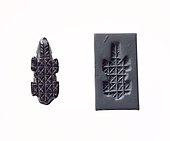
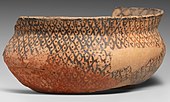




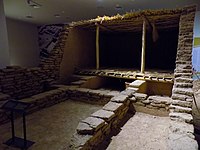




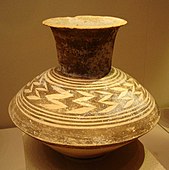
![Fragment of pottery with a painting of an Ibex; 4700-4200 BC; painted ceramic; from Girsu; Louvre[17]](http://upload.wikimedia.org/wikipedia/commons/thumb/2/27/Ubaid_IV_pottery_4700-4200_BC_Tello%2C_ancient_Girsu%2C_Louvre_Museum.jpg/115px-Ubaid_IV_pottery_4700-4200_BC_Tello%2C_ancient_Girsu%2C_Louvre_Museum.jpg)
![Female figurines; 4700-4200 BC; ceramic; from Girsu; Louvre[18]](http://upload.wikimedia.org/wikipedia/commons/thumb/4/43/Female_figurines_Ubaid_IV_Tello_ancient_Girsu_4700-4200_BC_Louvre_Museum.jpg/170px-Female_figurines_Ubaid_IV_Tello_ancient_Girsu_4700-4200_BC_Louvre_Museum.jpg)
![Terracotta stamp seal with Master of Animals motif, Tello, ancient Girsu, End of Ubaid period, Louvre Museum AO14165. Circa 4000 BC.[14]](http://upload.wikimedia.org/wikipedia/commons/thumb/b/b6/Stamp_seal_with_Master_of_Animals_motif%2C_Tello%2C_ancient_Girsu%2C_End_of_Ubaid_period%2C_Louvre_Museum_AO14165_%28detail%29.jpg/164px-Stamp_seal_with_Master_of_Animals_motif%2C_Tello%2C_ancient_Girsu%2C_End_of_Ubaid_period%2C_Louvre_Museum_AO14165_%28detail%29.jpg)
